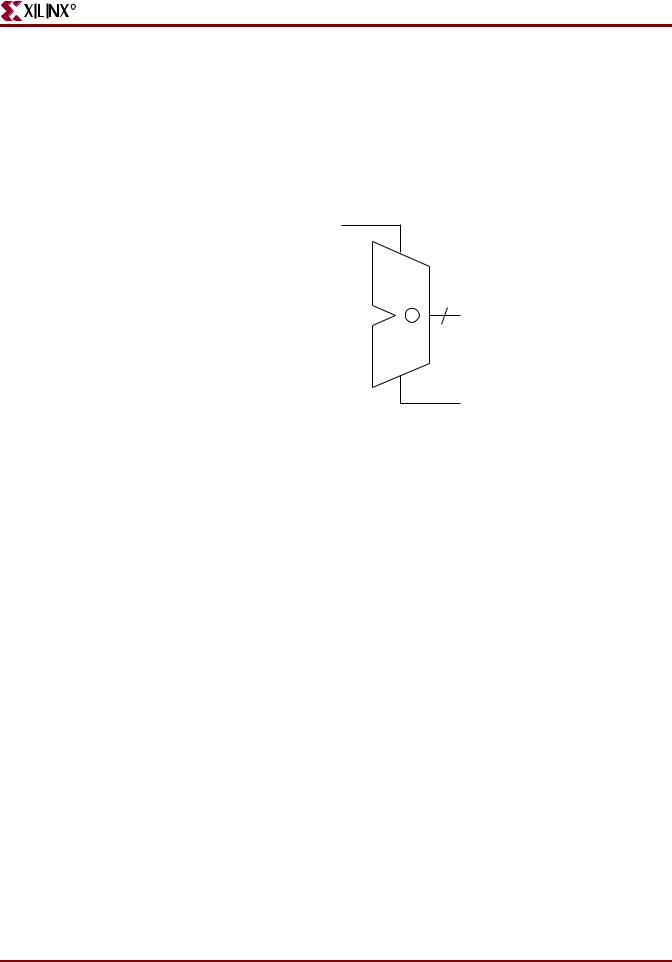
- •XST User Guide
- •Table of Contents
- •About the XST User Guide
- •XST User Guide Contents
- •Additional Resources
- •Conventions
- •Typographical
- •Online Document
- •1 Introduction to the XST User Guide
- •About XST
- •What’s New in Release 10.1
- •Macro Inference
- •Constraints
- •Libraries Support
- •Setting XST Options
- •2 XST HDL Coding Techniques
- •Signed and Unsigned Support in XST
- •Registers HDL Coding Techniques
- •About Registers
- •Registers Log File
- •Registers Related Constraints
- •Registers Coding Examples
- •Latches HDL Coding Techniques
- •About Latches
- •Latches Log File
- •Latches Related Constraints
- •Latches Coding Examples
- •Tristates HDL Coding Techniques
- •About Tristates
- •Tristates Log File
- •Tristates Related Constraints
- •Tristates Coding Examples
- •Counters HDL Coding Techniques
- •About Counters
- •Counters Log File
- •Counters Related Constraints
- •Counters Coding Examples
- •Accumulators HDL Coding Techniques
- •About Accumulators
- •Accumulators in Virtex-4 and Virtex-5 Devices
- •Accumulators Log File
- •Accumulators Related Constraints
- •Accumulators Coding Examples
- •Shift Registers HDL Coding Techniques
- •About Shift Registers
- •Describing Shift Registers
- •Implementing Shift Registers
- •Shift Registers Log File
- •Shift Registers Related Constraints
- •Shift Registers Coding Examples
- •Dynamic Shift Registers HDL Coding Techniques
- •About Dynamic Shift Registers
- •Dynamic Shift Registers Log File
- •Dynamic Shift Registers Related Constraints
- •Dynamic Shift Registers Coding Examples
- •Multiplexers HDL Coding Techniques
- •About Multiplexers
- •Multiplexers Case Statements
- •Multiplexers Log File
- •Multiplexers Related Constraints
- •Multiplexers Coding Examples
- •Decoders HDL Coding Techniques
- •About Decoders
- •Decoders Log File
- •Decoders Related Constraints
- •Decoders Coding Examples
- •Priority Encoders HDL Coding Techniques
- •About Priority Encoders
- •Priority Encoders Log File
- •Priority Encoders Related Constraints
- •Priority Encoders Coding Examples
- •Logical Shifters HDL Coding Techniques
- •About Logical Shifters
- •Logical Shifters Log File
- •Logical Shifters Related Constraints
- •Logical Shifters Coding Examples
- •Arithmetic Operators HDL Coding Techniques
- •About Arithmetic Operators
- •Arithmetic Operators Log File
- •Arithmetic Operators Related Constraints
- •Arithmetic Operators Coding Examples
- •About Adders, Subtractors, and Adders/Subtractors
- •Adders, Subtractors, and Adders/Subtractors Log File
- •Adders, Subtractors, and Adders/Subtractors Related Constraints
- •Adders, Subtractors, and Adders/Subtractors Coding Examples
- •Comparators HDL Coding Techniques
- •About Comparators
- •Comparators Log File
- •Comparators Related Constraints
- •Comparators Coding Examples
- •Multipliers HDL Coding Techniques
- •About Multipliers
- •Large Multipliers Using Block Multipliers
- •Registered Multipliers
- •Multipliers (Virtex-4, Virtex-5, and Spartan-3A D Devices)
- •Multiplication with Constant
- •Multipliers Log File
- •Multipliers Related Constraints
- •Multipliers Coding Examples
- •Sequential Complex Multipliers HDL Coding Techniques
- •About Sequential Complex Multipliers
- •Sequential Complex Multipliers Log File
- •Sequential Complex Multipliers Related Constraints
- •Sequential Complex Multipliers Coding Examples
- •Pipelined Multipliers HDL Coding Techniques
- •About Pipelined Multipliers
- •Pipelined Multipliers Log File
- •Pipelined Multipliers Related Constraints
- •Pipelined Multipliers Coding Examples
- •Multiply Adder/Subtractors HDL Coding Techniques
- •About Multiply Adder/Subtractors
- •Multiply Adder/Subtractors in Virtex-4 and Virtex- 5 Devices
- •Multiply Adder/Subtractors Log File
- •Multiply Adder/Subtractors Related Constraints
- •Multiply Adder/Subtractors Coding Examples
- •Multiply Accumulate HDL Coding Techniques
- •About Multiply Accumulate
- •Multiply Accumulate in Virtex-4 and Virtex-5 Devices
- •Multiply Accumulate Log File
- •Multiply Accumulate Related Constraints
- •Multiply Accumulate Coding Examples
- •Dividers HDL Coding Techniques
- •About Dividers
- •Dividers Log File
- •Dividers Related Constraints
- •Dividers Coding Examples
- •Resource Sharing HDL Coding Techniques
- •About Resource Sharing
- •Resource Sharing Log File
- •Resource Sharing Related Constraints
- •Resource Sharing Coding Examples
- •RAMs and ROMs HDL Coding Techniques
- •About RAMs and ROMs
- •RAMs and ROMs Log File
- •RAMs and ROMs Related Constraints
- •RAMs and ROMs Coding Examples
- •Initializing RAM Coding Examples
- •ROMs Using Block RAM Resources HDL Coding Techniques
- •About ROMs Using Block RAM Resources
- •ROMs Using Block RAM Resources Log File
- •ROMs Using Block RAM Resources Related Constraints
- •ROMs Using Block RAM Resources Coding Examples
- •Pipelined Distributed RAM HDL Coding Techniques
- •About Pipelined Distributed RAM
- •Pipelined Distributed RAM Log File
- •Pipelined Distributed RAM Related Constraints
- •Pipelined Distributed RAM Coding Examples
- •Finite State Machines (FSMs) HDL Coding Techniques
- •About Finite State Machines (FSMs)
- •Describing Finite State Machines (FSMs)
- •State Encoding Techniques
- •RAM-Based FSM Synthesis
- •Safe FSM Implementation
- •Finite State Machines Log File
- •Finite State Machines Related Constraints
- •Finite State Machines Coding Examples
- •Black Boxes HDL Coding Techniques
- •About Black Boxes
- •Black Box Log File
- •Black Box Related Constraints
- •Black Box Coding Examples
- •3 XST FPGA Optimization
- •About XST FPGA Optimization
- •Virtex-Specific Synthesis Options
- •Macro Generation
- •Virtex Macro Generator
- •Arithmetic Functions in Macro Generation
- •Loadable Functions in Macro Generation
- •Multiplexers in Macro Generation
- •Priority Encoders in Macro Generation
- •Decoders in Macro Generation
- •Shift Registers in Macro Generation
- •RAMs in Macro Generation
- •ROMs in Macro Generation
- •DSP48 Block Resources
- •Mapping Logic Onto Block RAM
- •About Mapping Logic Onto Block RAM
- •Mapping Logic Onto Block RAM Log Files
- •Mapping Logic Onto Block RAM Coding Examples
- •Flip-Flop Retiming
- •About Flip-Flop Retiming
- •Limitations of Flip-Flop Retiming
- •Controlling Flip-Flop Retiming
- •Partitions
- •Incremental Synthesis
- •About Incremental Synthesis
- •Incremental Synthesis (INCREMENTAL_SYNTHESIS)
- •Grouping Through Incremental Synthesis Diagram
- •Resynthesize (RESYNTHESIZE)
- •Speed Optimization Under Area Constraint
- •About Speed Optimization Under Area Constraint
- •Speed Optimization Under Area Constraint Examples
- •FPGA Optimization Log File
- •Design Optimization Report
- •Cell Usage Report
- •Timing Report
- •Implementation Constraints
- •Virtex Primitive Support
- •Instantiating Virtex Primitives
- •Generating Primitives Through Attributes
- •Primitives and Black Boxes
- •VHDL and Verilog Virtex Libraries
- •Virtex Primitives Log File
- •Virtex Primitives Related Constraints
- •Virtex Primitives Coding Examples
- •Using the UNIMACRO Library
- •Cores Processing
- •Specifying INIT and RLOC
- •About Specifying INIT and RLOC
- •Passing an INIT Value Via the LUT_MAP Constraint Coding Examples
- •Specifying INIT Value for a Flip-Flop Coding Examples
- •Specifying INIT and RLOC Values for a Flip-Flop Coding Examples
- •Using PCI Flow With XST
- •Satisfying Placement Constraints and Meeting Timing Requirements
- •Preventing Logic and Flip-Flop Replication
- •Disabling Read Cores
- •4 XST CPLD Optimization
- •CPLD Synthesis Options
- •About CPLD Synthesis Options
- •CPLD Synthesis Supported Devices
- •Setting CPLD Synthesis Options
- •Implementation Details for Macro Generation
- •CPLD Synthesis Log File Analysis
- •CPLD Synthesis Constraints
- •Improving Results in CPLD Synthesis
- •About Improving Results in CPLD Synthesis
- •Obtaining Better Frequency
- •Fitting a Large Design
- •5 XST Design Constraints
- •About Constraints
- •List of XST Design Constraints
- •XST General Constraints
- •XST HDL Constraints
- •XST FPGA Constraints (Non-Timing)
- •XST CPLD Constraints (Non-Timing)
- •XST Timing Constraints
- •XST Implementation Constraints
- •Third Party Constraints
- •Setting Global Constraints and Options
- •Setting Synthesis Options
- •Setting HDL Options
- •Setting Xilinx-Specific Options
- •Setting Other XST Command Line Options
- •Custom Compile File List
- •VHDL Attribute Syntax
- •Verilog-2001 Attributes
- •About Verilog-2001 Attributes
- •Verilog-2001 Attributes Syntax
- •Verilog-2001 Limitations
- •Verilog-2001 Meta Comments
- •XST Constraint File (XCF)
- •Specifying the XST Constraint File (XCF)
- •XCF Syntax and Utilization
- •Native and Non-Native User Constraint File (UCF) Constraints Syntax
- •XCF Syntax Limitations
- •Constraints Priority
- •XST-Specific Non-Timing Options
- •XST Command Line Only Options
- •XST Timing Options
- •XST Timing Options: Project Navigator > Process Properties or Command Line
- •XST Timing Options: Xilinx Constraint File (XCF)
- •XST General Constraints
- •Add I/O Buffers (–iobuf)
- •BoxType (BOX_TYPE)
- •Bus Delimiter (–bus_delimiter)
- •Case (–case)
- •Case Implementation Style (–vlgcase)
- •Verilog Macros (-define)
- •Duplication Suffix (–duplication_suffix)
- •Full Case (FULL_CASE)
- •Generate RTL Schematic (–rtlview)
- •Generics (-generics)
- •Hierarchy Separator (–hierarchy_separator)
- •I/O Standard (IOSTANDARD)
- •Keep (KEEP)
- •Keep Hierarchy (KEEP_HIERARCHY)
- •Library Search Order (–lso)
- •Netlist Hierarchy (-netlist_hierarchy)
- •Optimization Effort (OPT_LEVEL)
- •Optimization Goal (OPT_MODE)
- •Parallel Case (PARALLEL_CASE)
- •RLOC
- •Save (S / SAVE)
- •Synthesis Constraint File (–uc)
- •Use Synthesis Constraints File (–iuc)
- •Verilog Include Directories (–vlgincdir)
- •Verilog 2001 (–verilog2001)
- •HDL Library Mapping File (–xsthdpini)
- •Work Directory (–xsthdpdir)
- •XST HDL Constraints
- •About XST HDL Constraints
- •Automatic FSM Extraction (FSM_EXTRACT)
- •Enumerated Encoding (ENUM_ENCODING)
- •Equivalent Register Removal (EQUIVALENT_REGISTER_REMOVAL)
- •FSM Encoding Algorithm (FSM_ENCODING)
- •Mux Extraction (MUX_EXTRACT)
- •Register Power Up (REGISTER_POWERUP)
- •Resource Sharing (RESOURCE_SHARING)
- •Safe Recovery State (SAFE_RECOVERY_STATE)
- •Safe Implementation (SAFE_IMPLEMENTATION)
- •Signal Encoding (SIGNAL_ENCODING)
- •XST FPGA Constraints (Non-Timing)
- •Asynchronous to Synchronous (ASYNC_TO_SYNC)
- •Automatic BRAM Packing (AUTO_BRAM_PACKING)
- •BRAM Utilization Ratio (BRAM_UTILIZATION_RATIO)
- •Buffer Type (BUFFER_TYPE)
- •Extract BUFGCE (BUFGCE)
- •Cores Search Directories (–sd)
- •Decoder Extraction (DECODER_EXTRACT)
- •DSP Utilization Ratio (DSP_UTILIZATION_RATIO)
- •FSM Style (FSM_STYLE)
- •Power Reduction (POWER)
- •Read Cores (READ_CORES)
- •Resynthesize (RESYNTHESIZE)
- •Incremental Synthesis (INCREMENTAL_SYNTHESIS)
- •Logical Shifter Extraction (SHIFT_EXTRACT)
- •LUT Combining (LC)
- •Map Logic on BRAM (BRAM_MAP)
- •Max Fanout (MAX_FANOUT)
- •Move First Stage (MOVE_FIRST_STAGE)
- •Move Last Stage (MOVE_LAST_STAGE)
- •Multiplier Style (MULT_STYLE)
- •Mux Style (MUX_STYLE)
- •Number of Global Clock Buffers (–bufg)
- •Number of Regional Clock Buffers (–bufr)
- •Optimize Instantiated Primitives (OPTIMIZE_PRIMITIVES)
- •Pack I/O Registers Into IOBs (IOB)
- •Priority Encoder Extraction (PRIORITY_EXTRACT)
- •RAM Extraction (RAM_EXTRACT)
- •RAM Style (RAM_STYLE)
- •Reduce Control Sets (REDUCE_CONTROL_SETS)
- •Register Balancing (REGISTER_BALANCING)
- •Register Duplication (REGISTER_DUPLICATION)
- •ROM Extraction (ROM_EXTRACT)
- •ROM Style (ROM_STYLE)
- •Shift Register Extraction (SHREG_EXTRACT)
- •Slice Packing (–slice_packing)
- •Use Low Skew Lines (USELOWSKEWLINES)
- •XOR Collapsing (XOR_COLLAPSE)
- •Slice (LUT-FF Pairs) Utilization Ratio (SLICE_UTILIZATION_RATIO)
- •Map Entity on a Single LUT (LUT_MAP)
- •Use Carry Chain (USE_CARRY_CHAIN)
- •Convert Tristates to Logic (TRISTATE2LOGIC)
- •Use Clock Enable (USE_CLOCK_ENABLE)
- •Use Synchronous Set (USE_SYNC_SET)
- •Use Synchronous Reset (USE_SYNC_RESET)
- •XST CPLD Constraints (Non-Timing)
- •Clock Enable (–pld_ce)
- •Data Gate (DATA_GATE)
- •Macro Preserve (–pld_mp)
- •No Reduce (NOREDUCE)
- •WYSIWYG (–wysiwyg)
- •XOR Preserve (–pld_xp)
- •XST Timing Constraints
- •Applying Timing Constraints
- •Cross Clock Analysis (–cross_clock_analysis)
- •Write Timing Constraints (–write_timing_constraints)
- •Clock Signal (CLOCK_SIGNAL)
- •Global Optimization Goal (–glob_opt)
- •XCF Timing Constraint Support
- •Period (PERIOD)
- •Offset (OFFSET)
- •From-To (FROM-TO)
- •Timing Name (TNM)
- •Timing Name on a Net (TNM_NET)
- •Timegroup (TIMEGRP)
- •Timing Ignore (TIG)
- •XST Implementation Constraints
- •About Implementation Constraints
- •Implementation Constraints Syntax Examples
- •RLOC
- •NOREDUCE
- •PWR_MODE
- •XST-Supported Third Party Constraints
- •XST Equivalents to Third Party Constraints
- •Third Party Constraints Syntax Examples
- •6 XST VHDL Language Support
- •About XST VHDL Language Support
- •VHDL IEEE Support
- •About VHDL IEEE Support
- •VHDL IEEE Conflicts
- •Non-LRM Compliant Constructs in VHDL
- •XST VHDL File Type Support
- •About XST VHDL File Type Support
- •XST VHDL File Type Support Table
- •Debugging Using Write Operation in VHDL
- •Rules for Debugging Using Write Operation in VHDL
- •VHDL Data Types
- •Accepted VHDL Data Types
- •VHDL Overloaded Data Types
- •VHDL Multi-Dimensional Array Types
- •VHDL Record Types
- •VHDL Initial Values
- •About VHDL Initial Values
- •VHDL Local Reset/Global Reset
- •Default Initial Values on Memory Elements in VHDL
- •VHDL Objects
- •Signals in VHDL
- •Variables in VHDL
- •Constants in VHDL
- •VHDL Operators
- •Entity and Architecture Descriptions in VHDL
- •VHDL Circuit Descriptions
- •VHDL Entity Declarations
- •VHDL Architecture Declarations
- •VHDL Component Instantiation
- •VHDL Recursive Component Instantiation
- •VHDL Component Configuration
- •VHDL Generic Parameter Declarations
- •VHDL Generic and Attribute Conflicts
- •VHDL Combinatorial Circuits
- •VHDL Concurrent Signal Assignments
- •VHDL Generate Statements
- •VHDL Combinatorial Processes
- •VHDL If...Else Statements
- •VHDL Case Statements
- •VHDL For...Loop Statements
- •VHDL Sequential Circuits
- •About VHDL Sequential Circuits
- •VHDL Sequential Process With a Sensitivity List
- •VHDL Sequential Process Without a Sensitivity List
- •Register and Counter Descriptions VHDL Coding Examples
- •VHDL Multiple Wait Statements Descriptions
- •VHDL Functions and Procedures
- •About VHDL Functions and Procedures
- •VHDL Functions and Procedures Examples
- •VHDL Assert Statements
- •About VHDL Assert Statements
- •SINGLE_SRL Describing a Shift Register
- •Using Packages to Define VHDL Models
- •About Using Packages to Define VHDL Models
- •Using Standard Packages to Define VHDL Models
- •Using IEEE Packages to Define VHDL Models
- •Using Synopsys Packages to Define VHDL Models
- •VHDL Constructs Supported in XST
- •VHDL Design Entities and Configurations
- •VHDL Expressions
- •VHDL Statements
- •VHDL Reserved Words
- •7 XST Verilog Language Support
- •About XST Verilog Language Support
- •Behavioral Verilog
- •Variable Part Selects
- •Structural Verilog Features
- •About Structural Verilog Features
- •Structural Verilog Coding Examples
- •Verilog Parameters
- •Verilog Parameter and Attribute Conflicts
- •About Verilog Parameter and Attribute Conflicts
- •Verilog Parameter and Attribute Conflicts Precedence
- •Verilog Limitations in XST
- •Verilog Case Sensitivity
- •Verilog Blocking and Nonblocking Assignments
- •Verilog Integer Handling
- •Verilog Attributes and Meta Comments
- •About Verilog Attributes and Meta Comments
- •Verilog-2001 Attributes
- •Verilog Meta Comments
- •Verilog Constructs Supported in XST
- •Verilog Constants Supported in XST
- •Verilog Data Types Supported in XST
- •Verilog Continuous Assignments Supported in XST
- •Verilog Procedural Assignments Supported in XST
- •Verilog Design Hierarchies Supported in XST
- •Verilog Compiler Directives Supported in XST
- •Verilog System Tasks and Functions Supported in XST
- •Verilog Primitives
- •Verilog Reserved Keywords
- •Verilog-2001 Support in XST
- •8 XST Behavioral Verilog Language Support
- •Behavioral Verilog Variable Declarations
- •About Behavioral Verilog Variable Declarations
- •Behavioral Verilog Variable Declarations Coding Examples
- •Behavioral Verilog Initial Values
- •About Behavioral Verilog Initial Values
- •Behavioral Verilog Initial Values Coding Examples
- •Behavioral Verilog Local Reset
- •About Behavioral Verilog Local Reset
- •Behavioral Verilog Local Reset Coding Examples
- •Behavioral Verilog Arrays
- •Behavioral Verilog Multi-Dimensional Arrays
- •About Behavioral Verilog Multi-Dimensional Arrays
- •Behavioral Verilog Multi-Dimensional Arrays Coding Examples
- •Behavioral Verilog Data Types
- •About Behavioral Verilog Data Types
- •Behavioral Verilog Data Types Coding Examples
- •Behavioral Verilog Legal Statements
- •Behavioral Verilog Expressions
- •About Behavioral Verilog Expressions
- •Operators Supported in Behavioral Verilog
- •Expressions Supported in Behavioral Verilog
- •Results of Evaluating Expressions in Behavioral Verilog
- •Behavioral Verilog Blocks
- •Behavioral Verilog Modules
- •Behavioral Verilog Module Declarations
- •About Behavioral Verilog Module Declarations
- •Behavioral Verilog Module Declaration Coding Examples
- •Behavioral Verilog Continuous Assignments
- •About Behavioral Verilog Continuous Assignments
- •Behavioral Verilog Continuous Assignments Coding Examples
- •Behavioral Verilog Procedural Assignments
- •About Behavioral Verilog Procedural Assignments
- •Behavioral Verilog Combinatorial Always Blocks
- •Behavioral Verilog If...Else Statement
- •Behavioral Verilog Case Statements
- •Behavioral Verilog For and Repeat Loops
- •Behavioral Verilog While Loops
- •Behavioral Verilog Sequential Always Blocks
- •Behavioral Verilog Assign and Deassign Statements
- •Behavioral Verilog Assignment Extension Past 32 Bits
- •Behavioral Verilog Tasks and Functions
- •Behavioral Verilog Recursive Tasks and Functions
- •Behavioral Verilog Constant Functions
- •Behavioral Verilog Blocking Versus Non-Blocking Procedural Assignments
- •Behavioral Verilog Constants
- •Behavioral Verilog Macros
- •Behavioral Verilog Include Files
- •Behavioral Verilog Comments
- •Behavioral Verilog Generate Statements
- •Behavioral Verilog Generate For Statements
- •Behavioral Verilog Generate If... else Statements
- •Behavioral Verilog Generate Case Statements
- •9 XST Mixed Language Support
- •About Mixed Language Support
- •Mixed Language Project Files
- •VHDL and Verilog Boundary Rules in Mixed Language Projects
- •Instantiating a Verilog Module in a VHDL Design
- •Instantiating a VHDL Design Unit in a Verilog Design
- •Port Mapping in Mixed Language Projects
- •VHDL in Verilog Port Mapping
- •Verilog in VHDL Port Mapping
- •VHDL in Mixed Language Port Mapping
- •Verilog in Mixed Language Port Mapping
- •Generics Support in Mixed Language Projects
- •Library Search Order (LSO) Files in Mixed Language Projects
- •About the Library Search Order (LSO) File
- •Specifying the Library Search Order (LSO) File in Project Navigator
- •Specifying the Library Search Order (LSO) File in the Command Line
- •Library Search Order (LSO) Rules
- •10 XST Log Files
- •XST FPGA Log File Contents
- •XST FPGA Log File Copyright Statement
- •XST FPGA Log File Table of Contents
- •XST FPGA Log File Synthesis Options Summary
- •XST FPGA Log File HDL Compilation
- •XST FPGA Log File Design Hierarchy Analyzer
- •XST FPGA Log File HDL Analysis
- •XST FPGA Log File HDL Synthesis Report
- •XST FPGA Log File Advanced HDL Synthesis Report
- •XST FPGA Log File Low Level Synthesis
- •XST FPGA Log File Partition Report
- •XST FPGA Log File Final Report
- •Reducing the Size of the XST Log File
- •Use Message Filtering
- •Use Quiet Mode
- •Use Silent Mode
- •Hide Specific Messages
- •Macros in XST Log Files
- •XST Log File Examples
- •11 XST Naming Conventions
- •XST Net Naming Conventions
- •XST Instance Naming Conventions
- •XST Name Generation Control
- •12 XST Command Line Mode
- •Running XST in Command Line Mode
- •XST File Types in Command Line Mode
- •Temporary Files in Command Line Mode
- •Names With Spaces in Command Line Mode
- •Launching XST in Command Line Mode
- •Launching XST in Command Line Mode Using the XST Shell
- •Launching XST in Command Line Mode Using a Script File
- •Setting Up an XST Script
- •Setting Up an XST Script Using the Run Command
- •Setting Up an XST Script Using the Set Command
- •Setting Up an XST Script Using the Elaborate Command
- •Synthesizing VHDL Designs Using Command Line Mode
- •Synthesizing VHDL Designs Using Command Line Mode (Example)
- •Running XST in Script Mode (VHDL)
- •Synthesizing Verilog Designs Using Command Line Mode
- •Synthesizing Verilog Designs Using Command Line Mode (Example)
- •Running XST in Script Mode (Verilog)
- •Synthesizing Mixed Designs Using Command Line Mode
- •Synthesizing Mixed Designs Using Command Line Mode (Example)
- •Running XST in Script Mode (Mixed Language)

R
Arithmetic Operators HDL Coding Techniques
Arithmetic Operators HDL Coding Techniques
This section discusses Arithmetic Operators HDL Coding Techniques, and includes:
•“About Arithmetic Operators”
•“Arithmetic Operators Log File”
•“Arithmetic Operators Related Constraints”
•“Arithmetic Operators Coding Examples”
About Arithmetic Operators
XST supports the following arithmetic operators:
•Adders with:
♦Carry In
♦Carry Out
♦Carry In/Out
•Subtractors
•Adders/Subtractors
•Comparators (=, /=,<, <=, >, >=)
•Multipliers
•Dividers
Adders, subtractors, comparators and multipliers are supported for signed and unsigned operators.
For more information on signed and unsigned operators support in VHDL, see “Registers HDL Coding Techniques.”
Moreover, XST performs resource sharing for adders, subtractors, adders/subtractors and multipliers.
Arithmetic Operators Log File
The XST log file reports the type and size of recognized adder, subtractor and adder/subtractor during the Macro Recognition step.
...
Synthesizing Unit <adder>.
Related source file is arithmetic_operations_1.vhd. Found 8-bit adder for signal <sum>.
Summary:
inferred 1 Adder/Subtracter(s).
Unit <adder> synthesized. |
|
============================= |
|
HDL Synthesis Report |
|
Macro Statistics |
|
# Adders/Subtractors |
: 1 |
8-bit adder |
: 1 |
============================== |
|
XST User Guide |
www.xilinx.com |
111 |
10.1

Chapter 2: XST HDL Coding Techniques
R
Arithmetic Operators Related Constraints
•“Use DSP48 (USE_DSP48)”
•“DSP Utilization Ratio (DSP_UTILIZATION_RATIO)”
•“Keep (KEEP)”
Arithmetic Operators Coding Examples
The coding examples in this section are accurate as of the date of publication. Download updates from ftp://ftp.xilinx.com/pub/documentation/misc/examples_v9.zip. For examples of Arithmetic Operators, see the examples contained in the following sections:
•“Adders, Subtractors, and Adders/Subtractors HDL Coding Techniques”
•“Comparators HDL Coding Techniques”
•“Multipliers HDL Coding Techniques”
•“Sequential Complex Multipliers HDL Coding Techniques”
•“Pipelined Multipliers HDL Coding Techniques”
•“Multiply Adder/Subtractors HDL Coding Techniques”
•“Multiply Accumulate HDL Coding Techniques”
•“Dividers HDL Coding Techniques”
•“Resource Sharing HDL Coding Techniques”
Adders, Subtractors, and Adders/Subtractors HDL Coding
Techniques
This section discusses Adders, Subtractors, and Adders/Subtractors HDL Coding
Techniques, and includes:
•“About Adders, Subtractors, and Adders/Subtractors”
•“Adders, Subtractors, and Adders/Subtractors Log File”
•“Adders, Subtractors, and Adders/Subtractors Related Constraints”
•“Adders, Subtractors, and Adders/Subtractors Coding Examples”
About Adders, Subtractors, and Adders/Subtractors
The Virtex-4, Virtex-5, and Spartan-3A D families allow adders/subtractors to be implemented on DSP48 resources. XST supports the one level of output registers into DSP48 blocks. If the Carry In or Add/Sub operation selectors are registered, XST pushes these registers into the DSP48 as well.
XST can implement an adder/subtractor in a DSP48 block if its implementation requires only a single DSP48 resource. If an adder/subtractor macro does not fit in a single DSP48, XST implements the entire macro using slice logic.
Macro implementation on DSP48 blocks is controlled by “DSP Utilization Ratio (DSP_UTILIZATION_RATIO)” with a default value of auto. In auto mode, if an adder/subtractor is a part of a more complex macro such as a filter, XST automatically places it on the DSP block. Otherwise, XST implements adders/subtractors using LUTs. Set the value of “Use DSP48 (USE_DSP48)” to yes to force XST to push these macros into a DSP48. When placing an Adder/Subtractor on a DSP block, XST checks to see if it is
112 |
www.xilinx.com |
XST User Guide |
|
|
10.1 |

R
Adders, Subtractors, and Adders/Subtractors HDL Coding Techniques
connected to other DSP chains. If so, XST tries to take advantage of fast DSP connections, and connects this adder/subtractor to the DSP chain using these fast connections.
When implementing adders/subtractors on DSP48 blocks, XST performs automatic DSP48 resource control.
To deliver the best performance, XST by default tries to infer and implement the maximum macro configuration, including as many registers in the DSP48 as possible. Use the “Keep (KEEP)” constraint to shape a macro in a specific way. For example, to exclude the first register stage from the DSP48, place “Keep (KEEP)” constraints on the outputs of these registers.
Adders, Subtractors, and Adders/Subtractors Log File
Synthesizing Unit <v_adders_4>.
Related source file is "v_adders_4.v".
Found 8-bit adder carry in/out for signal <$addsub0000>. Summary:
inferred 1 Adder/Subtractor(s). Unit <v_adders_4> synthesized.
======================================================================
===
HDL Synthesis Report
Macro Statistics |
|
|
# Adders/Subtractors |
: |
1 |
8-bit adder carry in/out |
: |
1 |
======================================================================
===
Adders, Subtractors, and Adders/Subtractors Related Constraints
•“Use DSP48 (USE_DSP48)”
•“DSP Utilization Ratio (DSP_UTILIZATION_RATIO)”
•“Keep (KEEP)”
Adders, Subtractors, and Adders/Subtractors Coding Examples
The coding examples in this section are accurate as of the date of publication. Download updates from ftp://ftp.xilinx.com/pub/documentation/misc/examples_v9.zip.
•“Unsigned 8-Bit Adder”
•“Unsigned 8-Bit Adder With Carry In”
•“Unsigned 8-Bit Adder With Carry Out”
•“Unsigned 8-Bit Adder With Carry In and Carry Out”
•“Signed 8-Bit Adder”
•“Unsigned 8-Bit Subtractor”
•“Unsigned 8-Bit Subtractor With Borrow In”
•“Unsigned 8-Bit Adder/Subtractor”
XST User Guide |
www.xilinx.com |
113 |
10.1

Chapter 2: XST HDL Coding Techniques
R
Unsigned 8-Bit Adder
This section discusses Unsigned 8-Bit Adder, and includes:
•“Unsigned 8-Bit Adder Diagram”
•“Unsigned 8-Bit Adder Pin Descriptions”
•“Unsigned 8-Bit Adder VHDL Coding Example”
•“Unsigned 8-Bit Adder Verilog Coding Example”
8
|
|
A |
|
|
|
|
|
|
|
||
|
8 |
|
|||
|
+ |
SUM |
|||
|
8 |
|
|
||
|
|
B |
|
|
X10549 |
|
|
|
|||
|
|
|
|
|
|
|
Figure 2-37: Unsigned 8-Bit Adder Diagram |
||||
Table 2-45: Unsigned 8-Bit Adder Pin Descriptions |
|
||||
|
|
|
|
|
|
IO Pins |
|
Description |
|
||
|
|
|
|
|
|
A, B |
|
Add Operands |
|
||
|
|
|
|
|
|
SUM |
|
Add Result |
|
||
|
|
|
|
|
|
Unsigned 8-Bit Adder VHDL Coding Example
--
-- Unsigned 8-bit Adder
--
library ieee;
use ieee.std_logic_1164.all; use ieee.std_logic_unsigned.all;
entity adders_1 is
port(A,B : in std_logic_vector(7 downto 0); SUM : out std_logic_vector(7 downto 0));
end adders_1;
architecture archi of adders_1 is begin
SUM <= A + B;
end archi;
114 |
www.xilinx.com |
XST User Guide |
|
|
10.1 |

R
Adders, Subtractors, and Adders/Subtractors HDL Coding Techniques
Unsigned 8-Bit Adder Verilog Coding Example
//
// Unsigned 8-bit Adder
//
module v_adders_1(A, B, SUM); input [7:0] A;
input [7:0] B; output [7:0] SUM;
assign SUM = A + B;
endmodule
Unsigned 8-Bit Adder With Carry In
This section discusses Unsigned 8-Bit Adder With Carry In, and includes:
•“Unsigned 8-Bit Adder With Carry In Diagram”
•“Unsigned 8-Bit Adder With Carry In Pin Descriptions”
•“Unsigned 8-Bit Adder With Carry In VHDL Coding Example”
•“Unsigned 8-Bit Adder With Carry In Verilog Coding Example”
|
|
CI |
|
|
|
||
|
|
|
|
|
|||
|
8 |
|
|
|
|||
|
|
|
|
||||
|
|
A |
|
|
|
8 |
|
|
|
|
|||||
|
+ |
||||||
|
SUM |
||||||
|
8 |
|
|
|
|||
|
|
B |
|
|
|
X10550 |
|
|
|
|
|||||
|
|
|
|
|
|
|
|
|
Figure 2-38: Unsigned 8-Bit Adder With Carry In Diagram |
||||||
Table 2-46: Unsigned 8-Bit Adder With Carry In Pin Descriptions |
|||||||
|
|
|
|
|
|
|
|
IO Pins |
|
Description |
|
||||
|
|
|
|
|
|
|
|
A, B |
|
Add Operands |
|
||||
|
|
|
|
|
|
|
|
CI |
|
Carry In |
|
||||
|
|
|
|
|
|
|
|
SUM |
|
Add Result |
|
||||
|
|
|
|
|
|
|
|
Unsigned 8-Bit Adder With Carry In VHDL Coding Example
--
-- Unsigned 8-bit Adder with Carry In
--
library ieee;
XST User Guide |
www.xilinx.com |
115 |
10.1

Chapter 2: XST HDL Coding Techniques
R
use ieee.std_logic_1164.all; use ieee.std_logic_unsigned.all;
entity adders_2 is
port(A,B : in std_logic_vector(7 downto 0); CI : in std_logic;
SUM : out std_logic_vector(7 downto 0)); end adders_2;
architecture archi of adders_2 is begin
SUM <= A + B + CI;
end archi;
Unsigned 8-Bit Adder With Carry In Verilog Coding Example
//
// Unsigned 8-bit Adder with Carry In
//
module v_adders_2(A, B, CI, SUM); input [7:0] A;
input [7:0] B; input CI;
output [7:0] SUM;
assign SUM = A + B + CI;
endmodule
Unsigned 8-Bit Adder With Carry Out
This section discusses Unsigned 8-Bit Adder With Carry Out, and includes:
•“Unsigned 8-Bit Adder With Carry Out Diagram”
•“Unsigned 8-Bit Adder With Carry Out Pin Descriptions”
•“Unsigned 8-Bit Adder With Carry Out VHDL Coding Example”
•“Unsigned 8-Bit Adder With Carry Out Verilog Coding Example”
Before writing a + (plus) operation with carry out in VHDL, read the arithmetic package you plan to use. For example, std_logic_unsigned does not allow you to write + (plus) in the following form to obtain Carry Out:
Res(9-bit) = A(8-bit) + B(8-bit)
The reason is that the size of the result for + (plus) in this package is equal to the size of the longest argument (8 bits).
One solution for the example is to adjust the size of operands A and B to 9 bits using concatenation.
Res <= ("0" & A) + ("0" & B);
116 |
www.xilinx.com |
XST User Guide |
|
|
10.1 |

R
Adders, Subtractors, and Adders/Subtractors HDL Coding Techniques
In this case, XST recognizes that this 9-bit adder can be implemented as an 8-bit adder with carry out.
Another solution is:
•Convert A and B to integers
•Convert the result back to the std_logic vector
•Specify the size of the vector equal to 9
8
|
|
A |
|
|
|
8 |
|
|
|
|
|
|
|
||||
|
|
|
|
|
|
|
|
|
|
+ |
|
|
SUM |
||||
|
|
|
||||||
|
8 |
|
|
|
|
|
||
|
|
B |
|
|
|
|
|
CO |
|
|
|
|
|
||||
|
|
|
|
|
|
|
|
|
|
|
|
|
|
|
|
|
|
|
|
|
|
|
|
|
||
|
|
|
|
|
|
|
|
X10551 |
|
Figure 2-39: Unsigned 8-Bit Adder With Carry Out Diagram |
|||||||
Table 2-47: Unsigned 8-Bit Adder With Carry Out Pin Descriptions |
||||||||
|
|
|
|
|
|
|
|
|
IO Pins |
|
Description |
|
|
|
|||
|
|
|
|
|
|
|
|
|
A, B |
|
Add Operands |
|
|
|
|||
|
|
|
|
|
|
|
|
|
SUM |
|
Add Result |
|
|
|
|||
|
|
|
|
|
|
|
|
|
CO |
|
Carry Out |
|
|
|
|||
|
|
|
|
|
|
|
|
|
Unsigned 8-Bit Adder With Carry Out VHDL Coding Example
--
-- Unsigned 8-bit Adder with Carry Out
--
library ieee;
use ieee.std_logic_1164.all; use ieee.std_logic_arith.all; use ieee.std_logic_unsigned.all;
entity adders_3 is
port(A,B : in std_logic_vector(7 downto 0); SUM : out std_logic_vector(7 downto 0); CO : out std_logic);
end adders_3;
architecture archi of adders_3 is
signal tmp: std_logic_vector(8 downto 0); begin
tmp <= conv_std_logic_vector((conv_integer(A) + conv_integer(B)),9);
SUM <= tmp(7 downto 0);
XST User Guide |
www.xilinx.com |
117 |
10.1

Chapter 2: XST HDL Coding Techniques
R
CO <= tmp(8);
end archi;
The preceding example uses two arithmetic packages:
•std_logic_arith
Contains the integer to std_logic conversion function (conv_std_logic_vector)
•std_logic_unsigned
Contains the unsigned + (plus) operation
Unsigned 8-Bit Adder With Carry Out Verilog Coding Example
//
// Unsigned 8-bit Adder with Carry Out
//
module v_adders_3(A, B, SUM, CO); input [7:0] A;
input [7:0] B; output [7:0] SUM; output CO;
wire [8:0] tmp;
assign tmp = A + B; assign SUM = tmp [7:0]; assign CO = tmp [8];
endmodule
118 |
www.xilinx.com |
XST User Guide |
|
|
10.1 |

R
Adders, Subtractors, and Adders/Subtractors HDL Coding Techniques
Unsigned 8-Bit Adder With Carry In and Carry Out
This section discusses Unsigned 8-Bit Adder With Carry In and Carry Out, and includes:
•“Unsigned 8-Bit Adder With Carry In and Carry Out Diagram”
•“Unsigned 8-Bit Adder With Carry In and Carry Out Pin Descriptions”
•“Unsigned 8-Bit Adder With Carry In and Carry Out VHDL Coding Example”
•“Unsigned 8-Bit Adder With Carry In and Carry Out Verilog Coding Example”
CI
8 A 
8
+ SUM
8 B 
CO
X10552
Figure 2-40: Unsigned 8-Bit Adder With Carry In and Carry Out Diagram
Table 2-48: Unsigned 8-Bit Adder With Carry In and Carry Out Pin Descriptions
IO Pins |
Description |
|
|
A, B |
Add Operands |
|
|
CI |
Carry In |
|
|
SUM |
Add Result |
|
|
CO |
Carry Out |
|
|
Unsigned 8-Bit Adder With Carry In and Carry Out VHDL Coding Example
--
-- Unsigned 8-bit Adder with Carry In and Carry Out
--
library ieee;
use ieee.std_logic_1164.all; use ieee.std_logic_arith.all; use ieee.std_logic_unsigned.all;
entity adders_4 is
port(A,B : in std_logic_vector(7 downto 0); CI : in std_logic;
SUM : out std_logic_vector(7 downto 0); CO : out std_logic);
end adders_4;
architecture archi of adders_4 is
signal tmp: std_logic_vector(8 downto 0);
XST User Guide |
www.xilinx.com |
119 |
10.1

Chapter 2: XST HDL Coding Techniques
R
begin
tmp <= conv_std_logic_vector((conv_integer(A) + conv_integer(B) + conv_integer(CI)),9);
SUM <= tmp(7 downto 0); CO <= tmp(8);
end archi;
Unsigned 8-Bit Adder With Carry In and Carry Out Verilog Coding Example
//
// Unsigned 8-bit Adder with Carry In and Carry Out
//
module v_adders_4(A, B, CI, SUM, CO); input CI;
input [7:0] A; input [7:0] B; output [7:0] SUM; output CO;
wire [8:0] tmp;
assign tmp = A + B + CI; assign SUM = tmp [7:0]; assign CO = tmp [8];
endmodule
Signed 8-Bit Adder
This section discusses Signed 8-Bit Adder, and includes:
•“Signed 8-Bit Adder Diagram”
•“Signed 8-Bit Adder Pin Descriptions”
•“Signed 8-Bit Adder VHDL Coding Example”
•“Signed 8-Bit Adder Verilog Coding Example”
8 A 
8
+ SUM
8 B 
X10549
Figure 2-41: Signed 8-Bit Adder Diagram
120 |
www.xilinx.com |
XST User Guide |
|
|
10.1 |

R
Adders, Subtractors, and Adders/Subtractors HDL Coding Techniques
.
Table 2-49: Signed 8-Bit Adder Pin Descriptions
IO Pins |
Description |
|
|
A, B |
Add Operands |
|
|
SUM |
Add Result |
|
|
Signed 8-Bit Adder VHDL Coding Example
--
-- Signed 8-bit Adder
--
library ieee;
use ieee.std_logic_1164.all; use ieee.std_logic_signed.all;
entity adders_5 is
port(A,B : in std_logic_vector(7 downto 0); SUM : out std_logic_vector(7 downto 0));
end adders_5;
architecture archi of adders_5 is begin
SUM <= A + B;
end archi;
Signed 8-Bit Adder Verilog Coding Example
//
// Signed 8-bit Adder
//
module v_adders_5 (A,B,SUM); input signed [7:0] A; input signed [7:0] B; output signed [7:0] SUM; wire signed [7:0] SUM;
assign SUM = A + B;
endmodule
XST User Guide |
www.xilinx.com |
121 |
10.1

Chapter 2: XST HDL Coding Techniques
R
Unsigned 8-Bit Subtractor
This section discusses Unsigned 8-Bit Subtractor, and includes:
•“Unsigned 8-Bit Subtractor Diagram”
•“Unsigned 8-Bit Subtractor Pin Descriptions”
•“Unsigned 8-Bit Subtractor VHDL Coding Example”
•“Unsigned 8-Bit Subtractor Verilog Coding Example”
8 A 
|
8 |
|||||
|
8 |
|
|
SUM |
||
|
|
|
||||
|
|
|
|
|||
|
|
B |
|
|
|
X10553 |
|
|
|
||||
|
|
|
|
|
|
|
|
Figure 2-42: Unsigned 8-Bit Subtractor Diagram |
|||||
Table 2-50: Unsigned 8-Bit Subtractor Pin Descriptions |
||||||
|
|
|
|
|
|
|
IO Pins |
|
Description |
||||
|
|
|
|
|
|
|
A, B |
|
Sub Operands |
||||
|
|
|
|
|
|
|
RES |
|
Sub Result |
||||
|
|
|
|
|
|
|
Unsigned 8-Bit Subtractor VHDL Coding Example
--
-- Unsigned 8-bit Subtractor
--
library ieee;
use ieee.std_logic_1164.all; use ieee.std_logic_unsigned.all;
entity adders_6 is
port(A,B : in std_logic_vector(7 downto 0); RES : out std_logic_vector(7 downto 0));
end adders_6;
architecture archi of adders_6 is begin
RES <= A - B;
end archi;
122 |
www.xilinx.com |
XST User Guide |
|
|
10.1 |

R
Adders, Subtractors, and Adders/Subtractors HDL Coding Techniques
Unsigned 8-Bit Subtractor Verilog Coding Example
//
// Unsigned 8-bit Subtractor
//
module v_adders_6(A, B, RES); input [7:0] A;
input [7:0] B; output [7:0] RES;
assign RES = A - B;
endmodule
Unsigned 8-Bit Subtractor With Borrow In
This section discusses Unsigned 8-Bit Subtractor With Borrow In, and includes:
•“Unsigned 8-Bit Subtractor With Borrow In Pin Descriptions”
•“Unsigned 8-Bit Subtractor With Borrow In VHDL Coding Example”
•“Unsigned 8-Bit Subtractor With Borrow In Verilog Coding Example”
Table 2-51: Unsigned 8-Bit Subtractor With Borrow In Pin Descriptions
IO Pins |
Description |
|
|
A, B |
Sub Operands |
|
|
BI |
Borrow In |
|
|
RES |
Sub Result |
|
|
Unsigned 8-Bit Subtractor With Borrow In VHDL Coding Example
--
-- Unsigned 8-bit Subtractor with Borrow In
--
library IEEE;
use IEEE.STD_LOGIC_1164.ALL; use IEEE.STD_LOGIC_UNSIGNED.ALL;
entity adders_8 is
port(A,B : in std_logic_vector(7 downto 0); BI : in std_logic;
RES : out std_logic_vector(7 downto 0)); end adders_8;
architecture archi of adders_8 is
begin
RES <= A - B - BI;
end archi;
XST User Guide |
www.xilinx.com |
123 |
10.1

Chapter 2: XST HDL Coding Techniques
Unsigned 8-Bit Subtractor With Borrow In Verilog Coding Example
//
// Unsigned 8-bit Subtractor with Borrow In
//
module v_adders_8(A, B, BI, RES);
input |
[7:0] A; |
|
input |
[7:0] B; |
|
input |
|
BI; |
output |
[7:0] |
RES; |
assign |
RES = |
A - B - BI; |
endmodule
R
Unsigned 8-Bit Adder/Subtractor
This section discusses Unsigned 8-Bit Adder/Subtractor, and includes:
•“Unsigned 8-Bit Adder/Subtractor Diagram”
•“Unsigned 8-Bit Adder/Subtractor Pin Descriptions”
•“Unsigned 8-Bit Adder/Subtractor VHDL Coding Example”
•“Unsigned 8-Bit Adder/Subtractor Verilog Coding Example”
8
|
|
A |
|
|
|
|
|
|
|
8 |
|
|
|
|
|
|
|||||||
|
+/ |
|
|
|
|
||||||
|
|
|
|
|
SUM |
||||||
|
|
|
|
|
|||||||
|
8 |
|
|
|
|
|
|
|
|||
|
|
B |
|
|
|
|
|
|
|
|
|
|
|
|
|
|
|
||||||
|
OPER |
|
|
X10554 |
|||||||
|
|
|
|
||||||||
|
|
|
|
||||||||
|
Figure 2-43: Unsigned 8-Bit Adder/Subtractor Diagram |
||||||||||
Table 2-52: Unsigned 8-Bit Adder/Subtractor Pin Descriptions |
|||||||||||
|
|
|
|
|
|
|
|
|
|
|
|
IO Pins |
|
Description |
|
|
|||||||
|
|
|
|
|
|
|
|
|
|
|
|
A, B |
|
Add/Sub Operands |
|
|
|||||||
|
|
|
|
|
|
|
|
|
|
|
|
OPER |
|
Add/Sub Select |
|
|
|||||||
|
|
|
|
|
|
|
|
|
|
|
|
SUM |
|
Add/Sub Result |
|
|
|||||||
|
|
|
|
|
|
|
|
|
|
|
|
Unsigned 8-Bit Adder/Subtractor VHDL Coding Example
--
-- Unsigned 8-bit Adder/Subtractor
--
library ieee;
use ieee.std_logic_1164.all;
124 |
www.xilinx.com |
XST User Guide |
|
|
10.1 |
